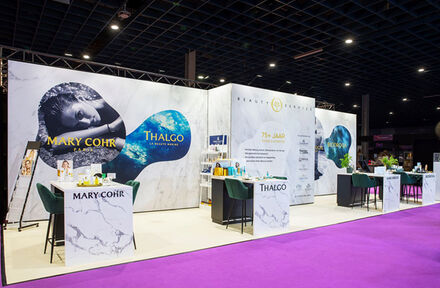Participating in a trade fair offers a great opportunity to present your brand, attract new customers and strengthen existing relationships. A well-designed trade fair stand plays a crucial role in this. In this guide, we discuss the essential elements for creating an effective and eye-catching trade fair stand, with practical tips for a successful trade fair participation.
1. The importance of a well-thought-out exhibition stand
A trade fair stand is more than just a physical space; it is a representation of your brand on a busy trade fair floor. A well-designed stand attracts attention, communicates your message clearly and invites visitors to engage in conversation. It is therefore essential to consider your target group, brand identity and the objectives of your trade fair participation when designing your stand.
2. Types of exhibition stands and their applications
There are different types of exhibition stands, each with their own characteristics and applications:
Row stand (intermediate stand): This stand is closed on three sides and open at the front. It is a common and cost-effective option for exhibitors on a budget.
Angle position:
Located on a corner of the show floor, this booth offers two open sides, providing extra visibility and accessibility.
Headstand:
This stand is open on three sides and offers maximum visibility. Ideal for exhibitors who want a prominent presence on the trade show floor.
Island position:
A freestanding stand with four open sides, suitable for large exhibitors who want to take a central position at the fair.
Choosing the right type of booth depends on your budget, goals and the available space on the exhibition floor. These choices can vary depending on the type of exhibitions you are active at.
3. Modular and mobile exhibition stands
Modular exhibition stands offer flexibility and are easy to adapt to different exhibition environments. They consist of reusable components that can be easily configured and expanded.
Mobile exhibition stands are lightweight and easy to transport, ideal for exhibitors who regularly attend trade fairs at different locations.
At AAA Display we offer a wide range of modular and mobile exhibition stands that are easy to assemble and have a professional look. These systems are also extremely suitable for international exhibitions.
4. Design principles for an effective trade show stand
An effective trade show booth combines functionality with aesthetics. Here are some design principles to keep in mind:
Consistent branding: Use your corporate colors, logo and typography to create a recognizable and professional look.
Clear message: Communicate your core message in a concise and visually appealing way.
Interactive elements: Integrate technology such as touchscreens or product demonstrations to engage visitors.
Lighting: Use directional lighting to draw attention to important elements of your booth.
Open and accessible layout: Create a layout that invites visitors to enter your booth and engage in conversation.
5. Preparation and logistics
A successful trade fair participation requires thorough preparation and planning:
Set objectives: Set clear goals for your trade show participation, such as lead generation, brand awareness or product launches.
Budgeting: Allow for costs such as booth rental, design, transportation, staff, and marketing materials.
Scheduling: Start planning well in advance to allow sufficient time for design, production and logistics.
Staff training: Make sure your team is well prepared to welcome visitors and present your products or services.
Well-planned logistics are especially important when you participate in several trade fairs per year.
6. Evaluation and follow-up
After the fair, it is important to evaluate the results of your participation:
Lead Follow-up: Contact the collected leads and schedule follow-up actions.
Objective Analysis: Evaluate whether you have achieved the stated objectives and identify areas for improvement for future trade shows.
Collect feedback: Ask for feedback from your team and visitors to gain insight into what worked well and what could be improved.
Conclusion
A successful trade show participation starts with a well-thought-out and professionally designed trade show stand. By considering the different types of stands, modular and mobile options, design principles and thorough preparation, you increase the chance of an effective and impactful presence on the trade show floor. Be inspired by the expertise of AAA Display and continue to evaluate and improve to get the most out of your trade show participations and future trade shows.
nl
Een beursdeelname biedt een uitgelezen kans om je merk te presenteren, nieuwe klanten aan te trekken en bestaande relaties te versterken. Een goed ontworpen beursstand speelt hierbij een cruciale rol. In deze gids bespreken we de essentiële elementen voor het creëren van een effectieve en opvallende beursstand, met praktische tips voor een succesvolle beursdeelname.
1. Het belang van een doordachte beursstand
Een beursstand is meer dan alleen een fysieke ruimte; het is een representatie van je merk op een drukbezochte beursvloer. Een goed ontworpen stand trekt de aandacht, communiceert je boodschap duidelijk en nodigt bezoekers uit om in gesprek te gaan. Het is daarom essentieel om bij het ontwerpen van je stand rekening te houden met je doelgroep, merkidentiteit en de doelstellingen van je beursdeelname.
2. Soorten beursstands en hun toepassingen
Er zijn verschillende typen beursstands, elk met hun eigen kenmerken en toepassingen:
Rijstand (tussenstand): Deze stand is aan drie zijden afgesloten en open aan de voorkant. Het is een veelvoorkomende en kosteneffectieve optie voor exposanten met een beperkt budget.
Hoekstand:
Gelegen op een hoek van de beursvloer, biedt deze stand twee open zijden, wat zorgt voor extra zichtbaarheid en toegankelijkheid.
Kopstand:
Deze stand is aan drie zijden open en biedt maximale zichtbaarheid. Ideaal voor exposanten die een prominente aanwezigheid willen op de beursvloer.
Eilandstand:
Een vrijstaande stand met vier open zijden, geschikt voor grote exposanten die een centrale positie op de beurs willen innemen.
Het kiezen van het juiste type stand hangt af van je budget, doelstellingen en de beschikbare ruimte op de beursvloer. Deze keuzes kunnen variëren afhankelijk van het soort beurzen waarop je actief bent.
3. Modulaire en mobiele beursstands
Modulaire beursstands bieden flexibiliteit en zijn eenvoudig aan te passen aan verschillende beursomgevingen. Ze bestaan uit herbruikbare componenten die gemakkelijk kunnen worden geconfigureerd en uitgebreid.
Mobiele beursstands zijn lichtgewicht en gemakkelijk te vervoeren, ideaal voor exposanten die regelmatig deelnemen aan beurzen op verschillende locaties.
Bij AAA Display bieden we een breed scala aan modulaire en mobiele beursstands die eenvoudig te monteren zijn en een professionele uitstraling hebben. Ook voor internationale beurzen zijn deze systemen uitermate geschikt.
4. Ontwerpprincipes voor een effectieve beursstand
Een effectieve beursstand combineert functionaliteit met esthetiek. Hier zijn enkele ontwerpprincipes om in gedachten te houden:
Consistente branding: Gebruik je huisstijlkleuren, logo en typografie om een herkenbare en professionele uitstraling te creëren.
Duidelijke boodschap: Communiceer je kernboodschap op een beknopte en visueel aantrekkelijke manier.
Interactieve elementen: Integreer technologie zoals touchscreens of productdemonstraties om bezoekers te betrekken.
Verlichting: Gebruik gerichte verlichting om aandacht te vestigen op belangrijke elementen van je stand.
Open en toegankelijke indeling: Zorg voor een lay-out die bezoekers uitnodigt om je stand binnen te lopen en in gesprek te gaan.
5. Voorbereiding en logistiek
Een succesvolle beursdeelname vereist grondige voorbereiding en planning:
Doelstellingen bepalen: Stel duidelijke doelen voor je beursdeelname, zoals leadgeneratie, merkbekendheid of productlanceringen.
Budgettering: Houd rekening met kosten voor standhuur, ontwerp, transport, personeel en marketingmateriaal.
Tijdsplanning: Begin ruim van tevoren met de planning om voldoende tijd te hebben voor ontwerp, productie en logistiek.
Training van personeel: Zorg ervoor dat je team goed voorbereid is om bezoekers te verwelkomen en je producten of diensten te presenteren.
Een goed geplande logistiek is vooral belangrijk wanneer je deelneemt aan meerdere beurzen per jaar.
6. Evaluatie en opvolging
Na de beurs is het belangrijk om de resultaten van je deelname te evalueren:
Leadopvolging: Neem contact op met de verzamelde leads en plan vervolgacties.
Analyse van doelstellingen: Evalueer of je de gestelde doelen hebt bereikt en identificeer verbeterpunten voor toekomstige beurzen.
Feedback verzamelen: Vraag feedback van je team en bezoekers om inzicht te krijgen in wat goed werkte en wat beter kan.
Conclusie
Een succesvolle beursdeelname begint met een goed doordachte en professioneel ontworpen beursstand. Door rekening te houden met de verschillende typen stands, modulaire en mobiele opties, ontwerpprincipes en grondige voorbereiding, vergroot je de kans op een effectieve en impactvolle aanwezigheid op de beursvloer. Laat je inspireren door de expertise van AAA Display en blijf evalueren en verbeteren om het maximale uit je beursdeelnames en toekomstige beurzen te halen.







